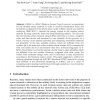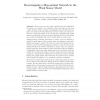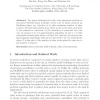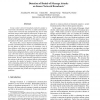ICESS
2005
Springer
14 years 5 months ago
2005
Springer
Abstract. In ad hoc sensor networks, sensor nodes have very limited energy resources, thus energy consuming operations such as data collection, transmission and reception must be k...
HPCC
2005
Springer
14 years 5 months ago
2005
Springer
S-MAC is a MAC (Medium Access Control) protocol as specialized for the wireless sensor network in order to sacrifice transmission delay and extend the working life of the whole sen...
EUC
2005
Springer
14 years 5 months ago
2005
Springer
Wireless sensor networks comprise of small nodes with sensing, computation and wireless communication capabilities. The energy efficiency is a substantial key design issues in suc...
ESA
2005
Springer
14 years 5 months ago
2005
Springer
Sensor nodes are very weak computers that get distributed at random on a surface. Once deployed, they must wake up and form a radio network. Sensor network bootstrapping research t...
DCOSS
2005
Springer
14 years 5 months ago
2005
Springer
The widespread dissemination of small-scale sensor nodes has sparked interest in a powerful new database abstraction for sensor networks: Clients “program” the sensors through ...
COCOON
2005
Springer
14 years 5 months ago
2005
Springer
The paper addresses the relay node placement problem in two-tiered wireless sensor networks. Given a set of sensor nodes in an Euclidean plane, our objective is to place minimum nu...
SENSYS
2005
ACM
14 years 5 months ago
2005
ACM
This paper describes a supercapacitor-operated, solar-powered wireless sensor node called Everlast. Unlike traditional wireless sensors that store energy in batteries, Everlast’...
SENSYS
2005
ACM
14 years 5 months ago
2005
ACM
We consider configuration of wireless sensor networks, where certain functions must be automatically assigned to sensor nodes, such that the properties of a sensor node (e.g., rem...
SP
2005
IEEE
14 years 5 months ago
2005
IEEE
So far, sensor network broadcast protocols assume a trustworthy environment. However, in safety and missioncritical sensor networks this assumption may not be valid and some senso...
PERCOM
2005
ACM
14 years 5 months ago
2005
ACM
Hybrid sensor networks comprise of mobile and static sensor nodes setup for the purpose of collaboratively performing tasks like sensing a phenomenon or monitoring a region. In th...




